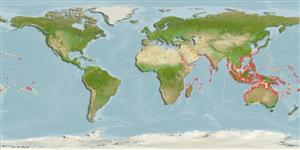>
Eupercaria/misc (Various families in series Eupercaria) >
Lutjanidae (Snappers) > Lutjaninae
Etymology: Lutjanus: Malay, ikan lutjan, name of a fish.
More on author: Forsskål.
Environment: milieu / climate zone / depth range / distribution range
Οικολογία
Θαλασσινό(ά); Υφάλμυρο Υφαλόφιλο(α); εύρος βάθους 3 - 35 m (Ref. 9710). Tropical; 31°N - 35°S, 20°E - 134°W (Ref. 55)
Indo-Pacific: Red Sea (Ref. 4320), Persian Gulf (Ref. 94051) and East Africa to Samoa, north to the Ryukyu Islands, south to Australia.
Length at first maturity / Μέγεθος / Βάρος / Age
Maturity: Lm 19.1, range 12 - ? cm
Max length : 50.0 cm TL αρσενικό/απροσδιόριστο; (Ref. 129178); common length : 30.0 cm TL αρσενικό/απροσδιόριστο; (Ref. 5450); μεγ. αναφερόμενη ηλικία: 23 έτη (Ref. 2290)
Ραχιαίες άκανθες (συνολικά): 10; Μαλακές ραχιαίες ακτίνες (συνολικά): 12-14; Εδρικές άκανθες 3; Μαλακές εδρικές ακτίνες: 8. This species is distinguished by the following characters: body moderately deep; greatest depth 2.6-2.9 in SL; preopercular notch and knob poorly developed; vomerine tooth patch triangular or diamond-shaped, with a medial posterior extension; gill rakers of first gill arch 6-7 + 9-12 (including rudiments) = 16-19; caudal fin truncate to slightly emarginate; scale rows on back rising obliquely above lateral line. Colour of back and upper sides brown, lower sides whitish or light brown and belly whitish to yellow, usually a series of 6-7 yellow stripes on the sides and a prominent black spot at level of lateral line, below base of anterior part of soft portion of dorsal fin (Ref. 9821, 90102).
Adults inhabit coral reefs (Ref. 30573, 58652), usually in schools on coastal reefs and in deep lagoons (Ref. 48635). Often in large aggregations with Lutjanus kasmira and Lutjanus lutjanus (Ref. 9710). Juveniles are sometimes found in mangrove estuaries or in the lower reaches of freshwater streams. Feed mainly on fishes, shrimps, crabs and other crustaceans (Ref. 30573). Caught mainly with handlines, traps, and gill nets. A small species, commonly utilized in subsistence fisheries but also seen frequently in markets where it is sold usually fresh (Ref. 9821). Neither anterolateral glandular groove nor venom gland is present (Ref. 57406, information in the table as dangerous fish, does not match; needs verification).
Allen, G.R., 1985. FAO Species Catalogue. Vol. 6. Snappers of the world. An annotated and illustrated catalogue of lutjanid species known to date. FAO Fish. Synop. 125(6):208 p. Rome: FAO. (Ref. 55)
IUCN Red List Status (Ref. 130435)
Threat to humans
Reports of ciguatera poisoning (Ref. 30298)
Human uses
αλιεία: Εμπορικό(ά); αλιεία αναψυχής: ναί; Ενυδρείο: Δημόσια ενυδρεία
Εργαλεία
Special reports
Download XML
Διαδικτυακές πηγές
Estimates based on models
Preferred temperature (Ref.
123201): 24.7 - 29.1, mean 28.1 °C (based on 1044 cells).
Phylogenetic diversity index (Ref.
82804): PD
50 = 0.5000 [Uniqueness, from 0.5 = low to 2.0 = high].
Bayesian length-weight: a=0.01585 (0.01384 - 0.01815), b=2.97 (2.94 - 3.00), in cm total length, based on LWR estimates for this species (Ref.
93245).
Τροφικό Επίπεδο (Ref.
69278): 3.8 ±0.3 se; based on diet studies.
Ελαστικότητα (Ref.
120179): Μεσαίο(α), ελάχιστος χρόνος για διπλασιασμό πληθυσμού 1,4 - 4,4 έτη (K=0.30; tmax=23).
Fishing Vulnerability (Ref.
59153): Low vulnerability (23 of 100).
Climate Vulnerability (Ref.
125649): Moderate vulnerability (40 of 100).
Nutrients (Ref.
124155): Calcium = 52.7 [35.4, 78.7] mg/100g; Iron = 0.428 [0.266, 0.685] mg/100g; Protein = 18.9 [17.4, 20.2] %; Omega3 = 0.145 [0.101, 0.212] g/100g; Selenium = 57.3 [35.1, 97.3] μg/100g; VitaminA = 101 [18, 389] μg/100g; Zinc = 0.609 [0.464, 0.858] mg/100g (wet weight); based on
nutrient studies.
